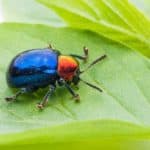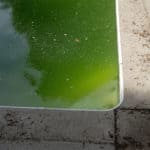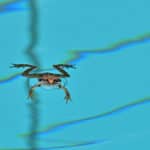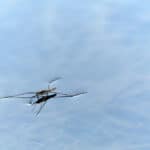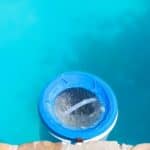Picture this: it’s a beautiful day, the sun is blazing through your window, and you already know that you want to spend the day outside. Your next thought? ‘A dip in the pool sounds amazing right now’. Swimming pools were made for days like these!
However, this dream is momentarily crushed when you discover little black and yellow dots floating along the surface of your outdoor family pool.
What are they, you ask? More importantly, how did they get there?

Water Bugs (And Where To Find Them)
As annoying as it may be, it is (unfortunately) very common to find bugs swimming around in your pool, basking in the sun like they’re paying the rent.
One of the most common types of water bug is the Water Boatman, a long, flat insect with stretched out legs, often colored black or grayish-brown. They can sometimes be confused for cockroaches due to their hard, oval-shaped exterior, but the main differences to look out for are:
- They can swim.
- They can grow much, much bigger.
The good news for those with critter phobias (Water Boatmen) is that they usually only grow as large as half an inch.
The bad news? Their bite has been known to be as painful as a bee sting, as their spiky mouthparts are created for stabbing their prey before sucking them dry.
Despite this, they are not technically harmful to humans… they just hurt quite a bit. The bites they leave behind can become itchy and sore, and overall inconvenient and annoying. No one wants to get bitten while enjoying what should have been a relaxing swim.
Oh… also, many species of water bugs can fly. As if swimming alone wasn't bad enough. So, while these creatures are around, don’t think you’re safe just because you’re avoiding the pool for the time being: in the words of Liam Neeson in the hit movie Taken, *‘They will find you, they will fly to you… and they will bite you.’
* Okay, Liam Neeson does not actually say this in the hit movie Taken.
Where Did They Come From? Where Do They Go?
One Word: algae.
Similar to cockroaches with rotting food, these bugs are attracted to the green goo. They lay their eggs within the algae, and they tend to breed pretty quickly. Some water bugs also eat the algae, as well as smaller bugs that have, unluckily, crossed paths with the little swimmers.
Other insects, such as mosquitos, may also lay their eggs amongst the sludge, and this will invite more critters to join the party as they will attempt to feast on the unborn blood-suckers… so, while some bugs will be eliminated without your help, this will lead to a larger infestation over time.
The same can be said for other insects that will inevitably drown in your pool, such as bumblebees, ladybugs, flies, and pretty much any bug you can think of: when their bodies hit the water, several other kinds of tiny vermin will then become attracted to the crime scene, seeing it as their own free-for-all buffet (a dip in the pool and table service - now that’s what you call a party, right?)
Outstaying Welcomes
The average lifespan of a Water Boatman, specifically, is around one year. This means these feisty critters can stick around for a long while, making their presence known for much longer than you would like them too.
Of course, during this time, they will have bred up to two times, all depending on the climate of your pool, so this loving family can create multiple generations within that time.
So, How Do Water Bugs Breed?
We’ll use Water Boatmen as an example: these little critters take part in a practice called ‘stridulation’, during which they massage their front legs against their heads, making a squeaky-sounding mating call.
Interestingly, this is similar to how crickets mate: you know that high-pitched sound you often hear in fields during summer time, the one you associate with crickets? That is the sound of them rubbing their legs together, attracting their own mate. How romantic!
When the mating process is complete, the female bug swims back into the water (probably your swimming pool) and lays her eggs amongst the algae and other plant matter. Her eggs will hatch within 1-2 weeks of being planted.
Water Boatmen go through a process known as ‘incomplete metamorphosis’, a type of development in which the insect goes through gradual changes while developing from the egg to an adult. This takes a couple of weeks.
When the babies have all grown up, they will grow wings and start flying around, as well as beginning to swim and breed all over again, restarting the process… and, therefore, doubling your infestation nightmare.
Bugs! What Are They Good For?
Despite the overall bad press, water bugs can actually help control the economical environment of your pool!
Some forms of water bugs help control algal and plant growth by feeding on the mush, and while they cause their own infestation, they help control other infestations by feeding on the larvae of other harmful insects, such as mosquitoes… so I suppose it all depends on which bug you decide you want to be bitten by!
So, To Conclude…
Overall, it seems that collecting water bugs in your family pool is almost inevitable. Your best bet is to clear the area of algae and dirt, regularly cleaning the pool as often as you can so you can limit the risk of them breeding.
Otherwise, maybe it’s time to just accept that humans and creatures can live together, side-by-side, in peace and harmony… at least, until one of them decides your leg looks particularly tasty.
If you’re not against the murder of (semi) harmless creatures, you can use your top-notch agile skills to squish the little beasts. Maybe that’s not the nicest way to go about it, though.
Just make sure you keep on top of your cleaning, cleansing the water at least once a week. After that, you can enjoy your perfect summer day in the pool with a nice, cold drink in hand… hopefully bug-free!

